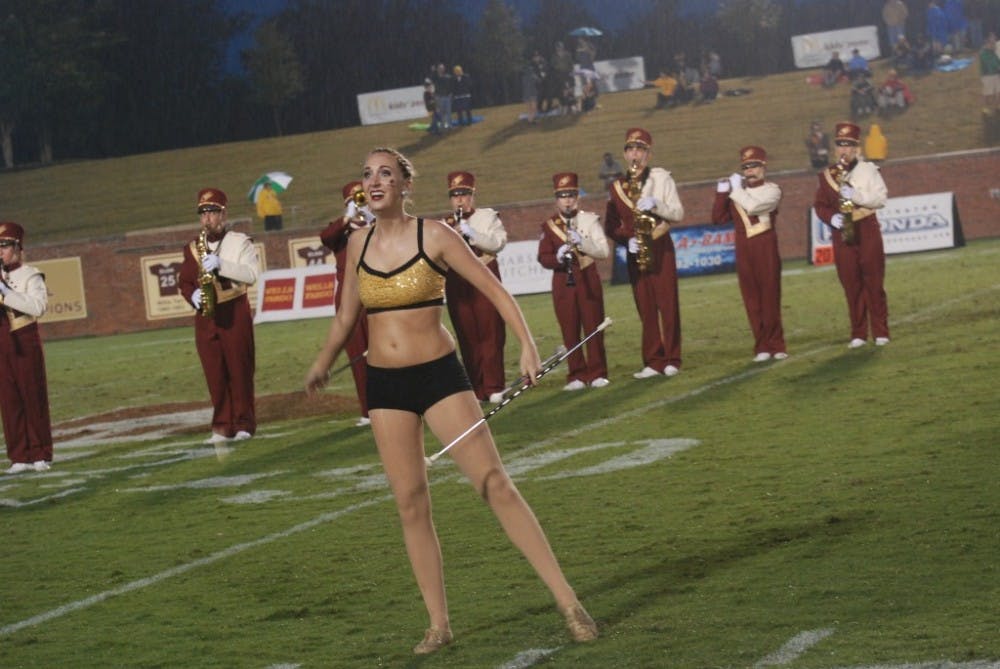Practice makes perfect, as the saying goes. In fact, bestselling author Malcolm Gladwell once said perfection requires spending 10,000 hours honing your skills.
If you’ve ever been to an Elon University football game, you have witnessed the skills of junior Kasia Luzynski, otherwise known as “the girl who twirls fire-lit batons” during the Fire of the Carolinas’ performance at half-time.
While other toddlers were learning the alphabet, Luzynski was busy making a life-changing decision. At the age of three, she decided she would devote her time to baton twirling.
Although this was the beginning of Luzynski’s formal twirling lessons, her mother, Terri Luzynski, said she believes her daughter’s affinity for twirling began much earlier.
“I think Kasia was born with a baton in her hand,” she said. “From the time she could walk, she carried around her older sister’s baton and tried to twirl with it.”
Luzynski’s older sister, Lindsie, and her younger sister, McKenna, are also passionate twirlers. The sport has created twirling traditions for the Luzynski family.
Her father, Tom Luzynski, refers to himself as a “beast of burden” — he is assigned the task of hauling costumes, equipment and suitcases around during competition season.
“Most families took vacations to the beach or to Disney World,” he said. “Ours were usually to regional or national baton twirling competitions.”
At the age of 12, Luzynski said she decided to take the next leap in her twirling career and began adding the element of fire to her performance.
“Looking back, I still don’t know how it happened,” she said. “I just remember wanting to do it and teaching myself how to do it. I had to learn all the safety precautions — like if you wear hairspray, your hair will catch on fire — so I had to be extremely mindful of things that could go wrong.”
Luckily, Luzynski has left every performance with nothing but a few singed arm hairs, which she shrugs off as “completely normal.”
“It’s ironic because I burn myself a lot while cooking,” she said. “Before the Appalachian State game this year, I burnt myself pretty badly with manicotti sauce.”
Greg Piel, a staff member of the Fire of the Carolinas who helps light Luzynski’s fire batons and ensures her safety, said he feels confident in Luzynski’s skills.
“She knows what she is capable of, and I believe she would never put herself or the band in a position of risk,” he said.
According to Piel, the Fire of the Carolinas has always had a twirler who used fire. In the 12 years he has been involved with the band, he has only witnessed one incident in which a twirler was burned while performing.
“Anytime fire is being used there has to be an element of safety,” Piel said. “We use holders and snuffers as a way to stabilize the batons while they are waiting for Kasia. On game days, Kasia knows where she wants the holders and snuffers [to be] and when she is expecting to have the batons lit. Her preparation makes game days real easy.”
Keeping the nature of twirling in mind, it’s no surprise Luzynski said the hardest aspect of twirling is getting through seasons uninjured.
“It’s a lot of stress on my body,” Luzynski said. “Last spring, I tore my hamstring. Last fall, I had to get MRIs on my hips because I lost all my cartilage.”
She said her experiences in physical therapy have shaped her decision to be an exercise science major at Elon.
When she’s not juggling knives and flaming batons, Luzynski is a committed Elon student. She is an avid member of the dance team, a part-time nanny, a participant in the Presbyterian Student Fellowship, an Alpha Xi Delta sorority member and a part-time employee of a country club.
She has also fully embraced the “fire lifestyle” — her car’s license plate reads “FIREGIRL” and she said she is ecstatic when #firegirl trends appear on Twitter.
But above all, Luzynski said it’s important to understand twirling takes countless hours of dedication.
Creating the artistic expression involved in baton twirling revolves around intricate timing, precision, complete concentration and coordination.
“It’s not just going out there and throwing some fire around,” she said. “For me, it took hours of practicing and essentially 17 years of training.”


